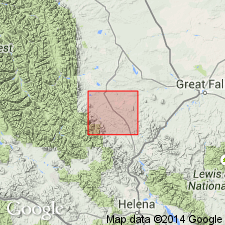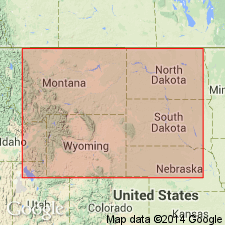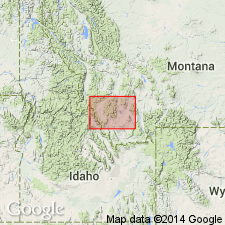
- Usage in publication:
-
- Montana group*
- Modifications:
-
- Overview
- AAPG geologic province:
-
- Denver basin
Summary:
Montana group. Age is Late Cretaceous. Recognized in Montana, Wyoming, Dakotas, Colorado, and Utah. Named from extensive development in Montana, especially in Upper Missouri River region.
G.H. Eldridge, 1888, Colorado Sci. Soc. Proc., v. 3, pt. 1, p. 93, footnote [see Wilmarth entry under Fox Hills sandstone].
A more elaborate description of Montana group was given by Eldridge in 1889 (Amer. Jour. Sci, 3rd ser., v. 38, p. 313-321). The original subdivisions of Fox Hills sandstone and Pierre shale are still recognized in the Dakotas, eastern Montana, eastern Wyoming, and eastern Colorado." In southern Montana, the group is now divided into (descending) Bearpaw shale, Judith River formation, Claggett shale, and Eagle sandstone. In northwestern Montana it is divided into (descending) Horsethief sandstone, Bearpaw shale, Two Medicine formation, and Eagle sandstone. In central and southern Wyoming it is divided into (descending) Lewis shale, Mesaverde formation, and Steele shale. In eastern Colorado the group is overlain by Laramie formation (Upper Cretaceous); in central southern Wyoming by Medicine Bow formation (Upper Cretaceous); and elsewhere in Wyoming and in Montana by Lance formation (Upper Cretaceous).
Source: US geologic names lexicon (USGS Bull. 896, p. 1404).

- Usage in publication:
-
- Montana Group
- Modifications:
-
- Revised
- Overview
- AAPG geologic province:
-
- Montana folded belt
Summary:
Typically consists of (ascending) Telegraph Creek Formation, Virgelle Sandstone, Two Medicine Formation, Bearpaw Shale, Horsethief Formation, St. Mary River Formation, and Willow Creek Formation; totaling about 5,000 ft in thickness in the Disturbed belt of northern Lewis and Clark Co, MT in Montana folded belt province. Revised along western margin of Disturbed belt in that the Big Skunk Formation (new), comprised of 2,100 ft of volcanic-rich, arkosic sedimentary rock, occupies the upper two-thirds of the Two Medicine stratigraphic interval. Age is Late Cretaceous.
Source: GNU records (USGS DDS-6; Denver GNULEX).

- Usage in publication:
-
- Montana Group*
- Modifications:
-
- Revised
- AAPG geologic province:
-
- Montana folded belt
- Central Montana uplift
- Williston basin
- Powder River basin
Summary:
Revised to include Hell Creek Formation as uppermost unit because of its lithogenetic similarities to underlying Cretaceous units; Miner Creek and St. Mary River Formations, Hell Creek equivalents, are not included within Montana. Telegraph Creek Formation considered basal part of Montana. Study area is within central MT in Lewis and Clark and Meagher Cos (Montana folded belt province), Wheatland, Golden Valley, and Fergus Cos (Central Montana uplift), Garfield Co (Williston basin), and Bighorn Co (Powder River basin). West-east cross section A-A' across central MT from Dearborn River to Porcupine dome (a distance of 300 mi) shows Montana Group to consist of (ascending) Telegraph Creek Formation, Virgelle Sandstone, and Two Medicine Formation, in Dearborn River area; Telegraph Creek, Virgelle Sandstone Member of Eagle Sandstone, main body of Eagle, Judith River Formation, Claggett Shale, Parkman Sandstone, Bearpaw Shale, Horsethief Sandstone, Lennep Sandstone, and Hell Creek Formation, in Bruno siding area; Gammon Shale, Claggett, Parkman, Bearpaw, Fox Hills Sandstone, and Hell Creek, in Porcupine dome area. Ammonite zones on cross sections. Cross section B-B' shows rocks equivalent to Montana Group in WY; section C-C' correlates Montana Group rocks in MT with equivalent rocks in WY. Table of stratigraphic nomenclature for MT and WY (fig. 12). Age is latest Santonian to late Maestrichtian (Late Cretaceous).
Source: GNU records (USGS DDS-6; Denver GNULEX).

- Usage in publication:
-
- Montana Group
- Modifications:
-
- Not used
Summary:
Rocks formerly assigned to the Montana Group in the Dillon area, southwest MT in the Montana folded belt province, are designated unnamed upper and lower parts of an unnamed sedimentary rock sequence of Early and Late Cretaceous age. These sedimentary rocks are younger than the Blackleaf Formation and older than the Beaverhead Group. Name Montana Group not used.
Source: GNU records (USGS DDS-6; Denver GNULEX).
For more information, please contact Nancy Stamm, Geologic Names Committee Secretary.
Asterisk (*) indicates published by U.S. Geological Survey authors.
"No current usage" (†) implies that a name has been abandoned or has fallen into disuse. Former usage and, if known, replacement name given in parentheses ( ).
Slash (/) indicates name conflicts with nomenclatural guidelines (CSN, 1933; ACSN, 1961, 1970; NACSN, 1983, 2005, 2021). May be explained within brackets ([ ]).

